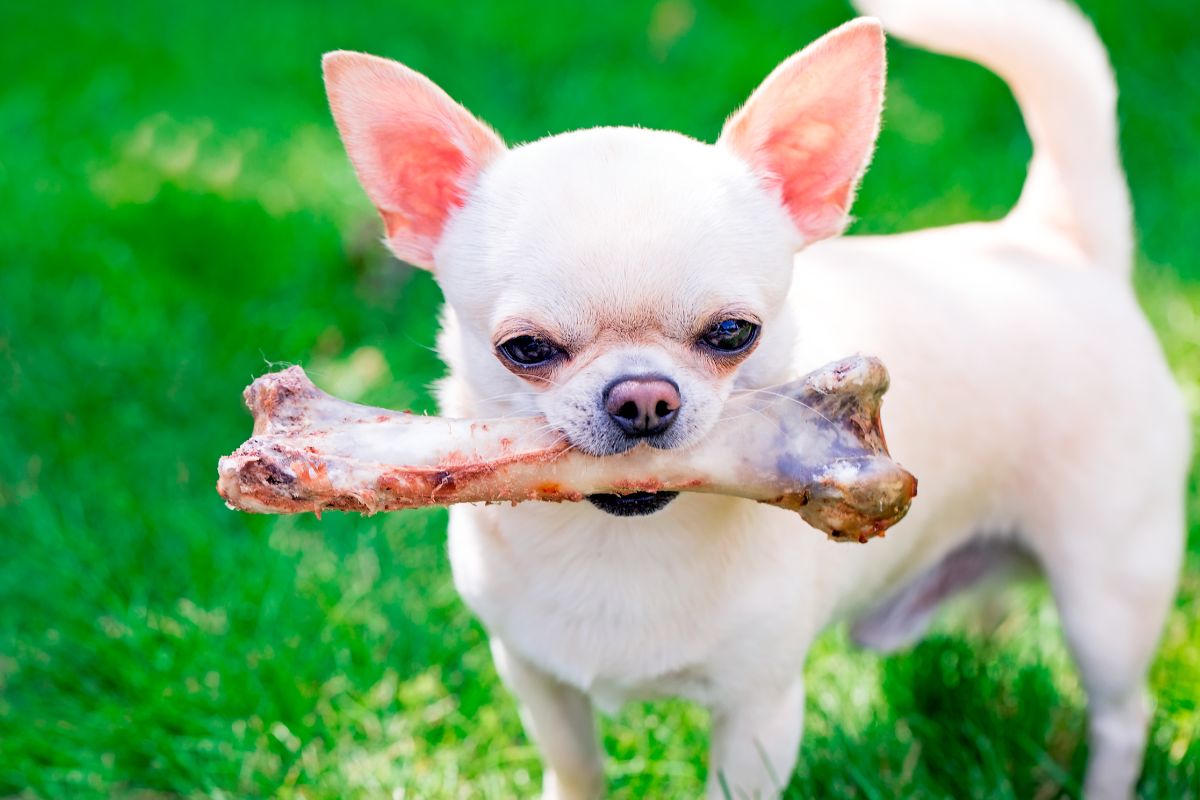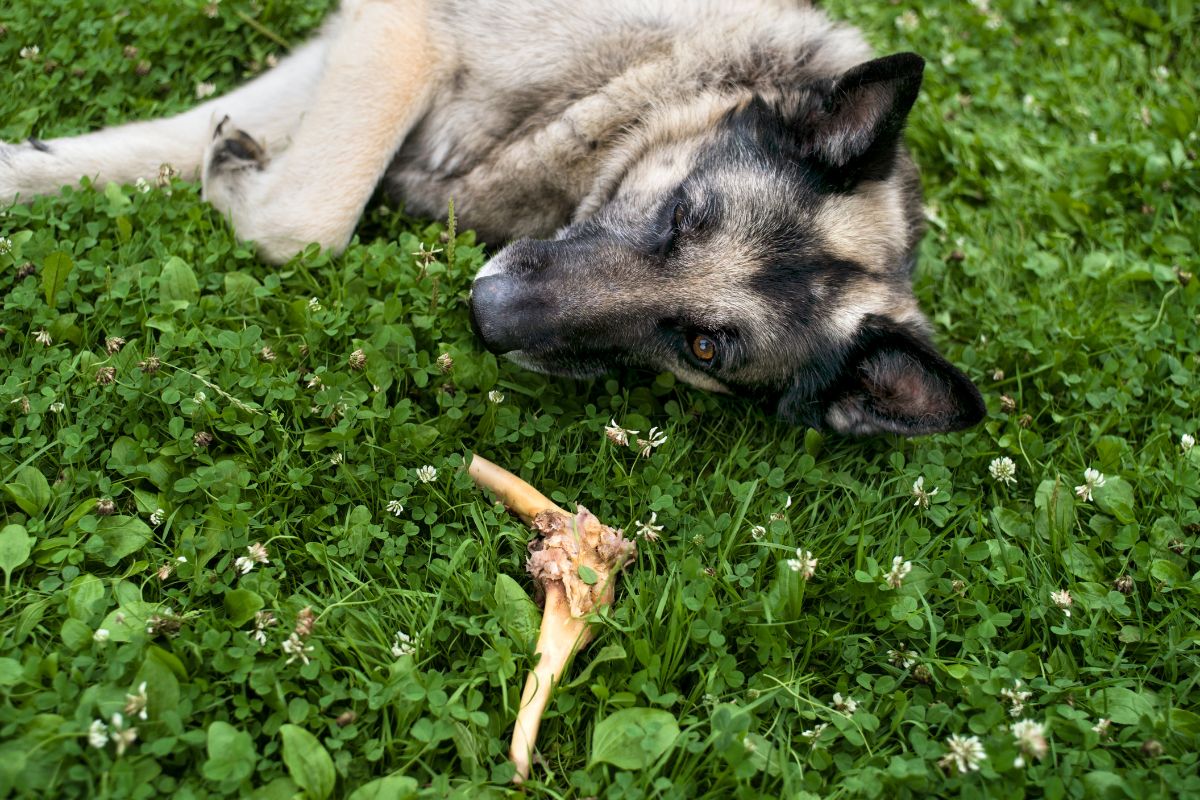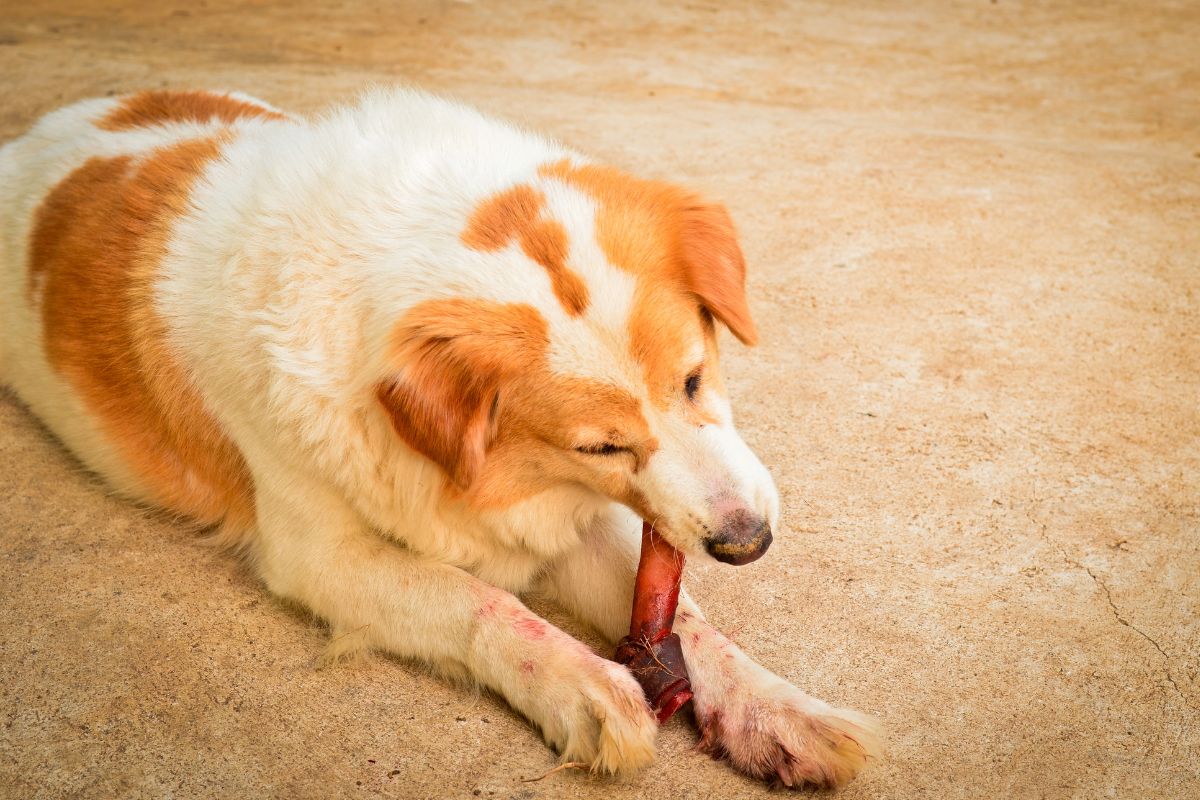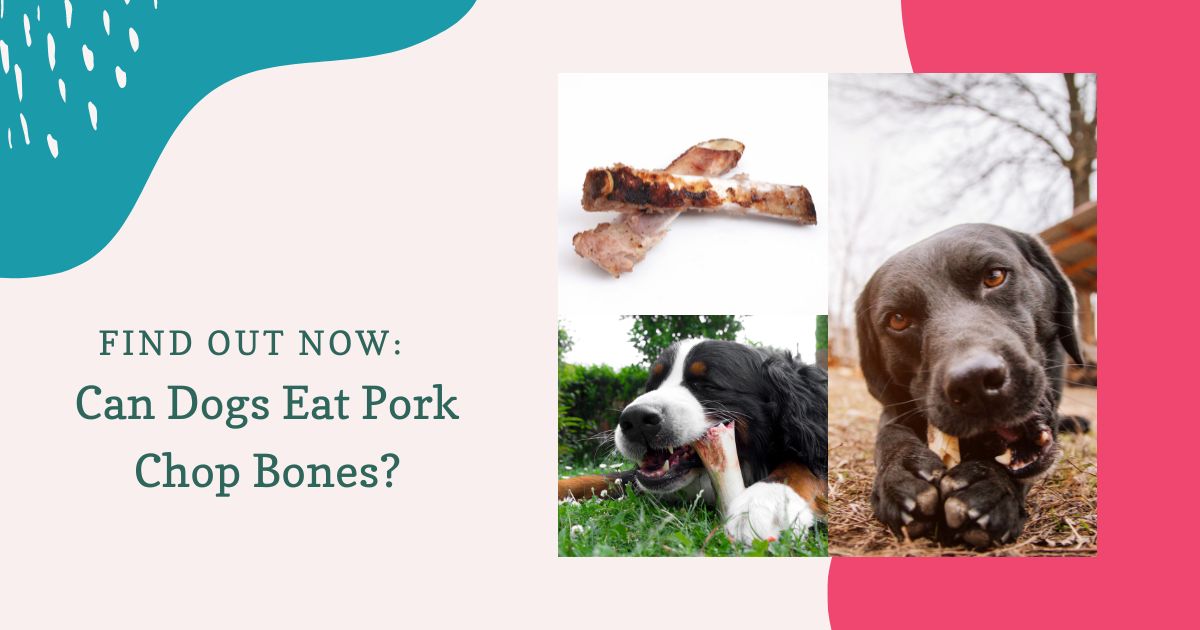Dogs Eating Bones
You may be wondering, can dogs eat pork chop bones or any other bones? Feeding your dog large, raw cow or bison bones is acceptable. The bones must be large enough to prevent your dog from attempting to swallow them, and they must be raw to prevent splintering.
Remember that after giving your dog bones, you should always supervise them. This article provides additional advice on safely giving your dog bones.

Benefits of Bones
Feeding your dog bones has numerous advantages, including satisfying their chewing urge, providing mental stimulation, relieving boredom, and making them happy.
Bones are a natural source of protein, minerals, and nutrients that contribute significantly to a healthy, well-balanced diet. Bones are also a good source of calcium and phosphorus, important nutrients for growing puppies. If you feed your dog meat bones, they are also a good source of glucosamine and chondroitin sulfate, which are essential for joint health.
Additionally, bones are an excellent source of dietary fiber, which can aid digestion and may lower the risk of certain cancers.
In addition to being nutritious, many dogs enjoy gnawing on bones, which can aid in dental hygiene and keep your dog’s teeth and gums healthy. While adding raw, fresh bones to your dog’s diet will not replace regular vet visits for dental cleaning, it will help to reduce the incidence of canine tooth disease.
Can Dogs Eat Pork Chop Bones?
Can dogs eat pork bones? Well, that question is worth a million dollars, as many pet owners would pay a significant price to protect their dogs. The answer is yes. However, it depends on the specifics, such as the size of the bones and whether they are raw or cooked.
From a dog’s perspective, there is hardly a time when treats are inappropriate. The fact is, dogs devour bones with gusto, as well as anything else you give them.
However, not all treats come from high-quality ingredients, and some are harmful to dogs.
Also, as a pet parent, it can be difficult to distinguish between acceptable and unacceptable treats. Bones are one of the most frequently debated treats.
Can Dogs Eat Pork Chops?
Many regard pork chops as safe, but they are not always healthy just like processed meats. If your dog enjoys pork, it’s best to serve it cooked without any extras humans enjoy.
Your dog can eat pork without toxic seasonings, sauces, condiments, onions, or other ingredients. As a result of its high-fat content, pork chops for dogs are best as occasional treats than as a mainstay in your dog’s diet. Also, before regularly including pork in your dog’s diet, consult your veterinarian if you have any concerns.
Can Dogs Eat Raw Pork?
Dogs shouldn’t consume raw pork. Raw or undercooked pork meat may contain parasites that can infect both dogs and humans. For these reasons, you should always cook pork before feeding it to your dog.
Although trichinella infections are uncommon, they can be severe. Trichinella, also called trichinosis, is a parasitic infection resulting in roundworms (nematodes). The nematodes are caused by consuming raw or undercooked meat, such as pork. Their symptoms include vomiting, diarrhea, lethargy, and fever.
This parasite exists as larvae in the muscle tissue of pigs and, after ingestion by a dog, will mature into its adult form in the dog’s intestines. In addition, dogs fed a raw diet may ingest harmful bacteria found in raw meats and bones.
Can Dogs Eat Cooked Pork?
Yes, dogs can consume cooked pork in moderation. However, do add any seasoning. Also, be sure to remove the fat from pork before feeding it to your dog. Excessive fat can cause canine stomach upset.
Even though the answer to the question “can dogs eat pork?” is not simple, the takeaway is that while pork is not an essential part of a dog’s diet, it can be an occasional treat. If you want to treat your pet to this delicious meat:
- Serve it in moderation, always cooked, and never with bones or seasoning.
- Always remove the fat first, and consult your veterinarian beforehand if they have advised that your pet may have problems with fatty foods.
Can Canines Eat ANY Bones Safely?
It is a myth that dogs require bone chewing. Bones are hazardous and can cause severe injuries to dogs, even though they are a dog’s favorite. The following are the top reasons why bones are bad for dogs:
- Broken teeth: Due to the extreme hardness and fragility of bones, it is easy for a dog to break one of its large chewing teeth. A fractured tooth is painful and requires treatment. This is an expensive exercise, regardless of whether you extract or save the tooth with a root canal.
- Damage to the oral cavity and tongue: Broken bone fragments can have razor-sharp edges, which can pierce the tongue, cheek, or soft palate on the roof of the mouth.
- Bones can encircle the lower jaw: Around the lower jaw, round bones can become lodged behind the lower canine teeth. Most dogs need sedation to extract the bone, which is a terrifying experience for them.
- Bones can choke the dog: Bone fragments can become lodged in the esophagus en route to the stomach. It is also possible for a bone fragment to enter the trachea (windpipe), preventing your dog from breathing. Furthermore, choking is a medical emergency!
- Gastrointestinal and intestinal lining injuries: Bone fragments can harm the dog’s mouth, stomach, and intestines. In some instances, bone fragments may completely perforate the stomach or intestine walls, allowing food and intestinal contents to leak into the abdomen. This results in peritonitis, an abdominal infection that can be fatal despite aggressive treatment.
- Bones may become lodged in the stomach: Depending on the size of the bone fragment, it may be impossible for it to exit the stomach. Remaining bone fragments in the gut can cause chronic vomiting and stomach irritation. These retained bone fragments require abdominal surgery or endoscopy for removal.
- Bones can obstruct the small intestine or the colon: Fragments of bone can become lodged in the small intestines, resulting in intestinal obstruction that necessitates surgery. Bone fragments traveling through the gastrointestinal (GI) tract and reaching the large intestine/colon may accumulate and cause constipation. Bone fragments may scrape the lining of the colon and rectum, causing significant trauma to the dog. To evacuate the large bowel, enemas and manipulation may be necessary.
- Pathogen contamination of raw bones: Raw meat and bones may contain E. coli, Salmonella species, and Listeria, among other pathogens. Depending on the dog’s health, these pathogens may or may not make a dog sick.

Other Bones to Avoid Giving a Dog
Small Bones
Small bones fit easily in your dog’s mouth; these are the bones that your dog may ingest. Dogs should never eat tiny bones because minute fragments can lodge in their windpipes.
Some dogs are picky eaters, but the vast majority are not. They enjoy chewing on bones, pork, and anything covered in peanut butter. Therefore, you must be cautious with what you feed them, especially leftover “human food.”
Cooked Pork Bones
Have any pork bones left over? It can be tempting to toss them to your dog rather than discard them. Please don’t do it! The cooking process renders bones softer and more brittle.
How does this affect your dog? Brittle bones are more likely to shatter when your dog chews on them. Also, sharp edges can cause severe problems, such as tooth fractures and other oral injuries. They can even cause life-threatening blockages and intestinal damage to your dog.
Raw Pork Bones
Even uncooked pork bones can cause problems. These uncooked bones can shatter and splinter similarly to cooked pork bones. Therefore, it is best to avoid feeding your dog raw bones for the same reasons as cooked bones.
Why are Pork Bones Bad for Dogs?
There are numerous dangers associated with dogs eating pork chop bones. These include bone splinter damage, bowel obstruction, and dental problems. However, these are just risks. This means that your dog may be fine after consuming a bone.
However, because there are risks, it is not worth endangering your dog’s health on purpose by feeding them the leftovers from yesterday’s barbecue.
What to do if Your Dog Eats a Pork Bone
Do not panic if your dog obtains a pork bone. You must maintain composure and take action. Also, if you immediately discipline your dog, they may become even more frightened, making it more challenging to take them to the veterinarian. However, you can minimize distractions by maintaining composure through the following steps:
Examine Your Dog First
Examine the animal for signs of distress, such as gagging, choking, or pawing at the mouth, which may require immediate veterinary care. Immediately contact the veterinarian if any of these symptoms are present. Please do not attempt to retrieve any object from your dog’s mouth or throat unless it is visible on their tongue and poses no risk when removed.
Clean up
Clean up any spilled garbage or bone fragments to ensure the safety of your dog and any other dogs in the home. It may be necessary to confine your dog to a crate or room during this process. Ensure that they cannot find any leftovers to consume.
Call Your Vet
Even if your dog appears healthy, you should seek veterinary advice. Large missing bones are cause for concern, but your veterinarian will be able to provide you with personalized advice. They will likely ask you to observe for symptoms of a problem, including vomiting, diarrhea, bloody stools, abdominal pain, and lethargy.
Do not Induce Vomiting
Unless your veterinarian instructs you to do so, you should not make your dog vomit over a bone. Inducing vomiting in a dog may result in additional complications.
Observe Changes
If you observe behavior changes in your dog that persist for more than a few hours, you should schedule an emergency appointment with your veterinarian. If your dog is fortunate enough to pass a whole bone or bone fragment, you should find it in its feces approximately 48 hours after ingestion.
Further, your veterinarian may ask you to “pad” your pet’s stomach with bread, pumpkin, or other foods to solidify stools around the foreign object.
Additionally, to avoid a recurrence of this situation, you may wish to find a better way to secure your trash can! Dogs are extremely curious animals. They always seem to follow their nose, especially if it leads them to a treasure trove of potential tasty treats.
Your dog’s access to the trash allows it to sample a variety of foods. Many of which are extremely hazardous to their health.
Can a Dog Digest a Pork Bone?
Their digestive system allows them to consume a wide variety of foods. However, dogs may have trouble digesting pork bones.
A pork bone may pass through the dog’s stomach without being digested due to its size. Consequently, it may also traverse the intestines. When this bone splinters, its edges will be problematic.
The issue with pork bones is that they are too large and dense for dogs to digest. In addition, even if your pet bites and chews on the bone, its sharp edges can cause damage to its throat. It can also cause choking, intestinal obstructions, and esophageal or intestinal damage.
How Long Does a Dog Take to Digest a Pork Bone?
Among all mammals, dogs have the smallest digestive system. Consequently, they can complete the entire process in approximately eight hours. It would vary based on the dog’s breed and size. If your pet consumed a pork bone, it probably wouldn’t take long for it to pass.
Can Pork Bone Kill a Dog?
A pork bone can kill a dog if it causes choking or intestinal obstruction. All incidents involving the consumption of bones are hazardous for dogs. Consequently, if left unchecked or untreated, it can kill your pet. For instance, choking can be fatal to your pet if you do not intervene immediately.
To remedy intestinal obstructions, an operation or other complex treatment is required. Nonetheless, circumstances would fluctuate occasionally, and you must consider numerous variables.
For instance, not all bones are equal. Certain bones are more pleasant to chew than others. Some bones tend to disintegrate, while others fracture and produce sharp edges. If your dog consumed bird bones, they would be thin, air-filled, and easily broken.
However, pork bones from pigs and beef bones from cattle are enormous. The severity of your pet’s incident generally depends on the following variables.
- The condition of your dog’s teeth.
- The size of the bone.
- The size and health of your dog.
- The type of bone.
- The relative tendency of your dog to chew on her food.
If your dog’s symptoms are severe, you should take it to the veterinarian immediately.
How to Use Pork Bones Safely as Canine Treats
If you want to avoid wasting those pork bones, you could use them to make broth. Mix a small quantity of broth into your dog’s food to add flavor. Before doing so, consult your veterinarian, especially if your dog has intestinal or dietary issues.
Which Bones are Appropriate for Dogs?
Bones can be a delicious dog treat, but choosing the right bone for your dog is essential. Bones can splinter into sharp pieces that could harm your dog’s throat, esophagus, or intestines.
Also, while giving your dog your leftover bones may be tempting, it is safer not to. Cooked bones may break more easily than raw bones and pose health risks to your dog. You should always supervise your dog when chewing on a bone and remove it if it begins to fracture.
Below are some dog-friendly bones that provide all the nutritional benefits your dog craves.
Raw Bones
Bones of lamb or beef are safe for dogs. They are soft enough that there is little risk of the bones breaking into harmful pieces, and your dog should have no trouble digesting them.
Additionally, you should always watch your dog closely while It chews the bone. If the bone fragments are excessively large, they may pose a choking hazard. Also, observe the stool your dog produces after consuming a bone to ensure it appears normal.
Additionally, if you feed your dog raw bones, ensure they are fresh, as rotting bones may cause stomach upset. As you would with raw meat for humans, handle raw bones by keeping them cold and contamination-free. Before offering raw bones to your dog, blanch them in boiling water for one minute, eliminating bacteria without causing the bone to become brittle.
Marrow Bones
Marrow bones are irresistible to most dogs. The marrow contains delicious fat, and the exterior of the bone is enjoyable to chew. Due to the high marrow content, these bones may upset your dog’s stomach; therefore, serve them in moderation.
Hooves
Although hooves are not technically bones, they provide a similar tactile experience without the risk of breaking. To create a tasty treat for your dog, you can stuff the cow hooves with peanut butter, mashed pumpkin, and other delectable substances.
Slow-Cooked Bones
Bones simmered eliminate harmful bacteria without rendering them brittle and prone to fracture. They are an excellent source of iron and other minerals and are also free of hormones and chemicals.

Tips and Tricks on Safely Feeding Bones to Dogs
So how do you safely feed pork bones to your dog?
- Long dog bones are the best: The bone should be large enough. Because larger breeds have larger and sharper teeth, they can easily shatter smaller bones, making them dangerous.
- Do not completely abandon your dog: When offering your dog a bone as a treat, it is best to maintain vigilance. Check periodically to ensure your dog’s teeth have not penetrated the bone.
- You should not let your dog gnaw on bones continuously: It is tempting to give your dog a bone and allow it to consume it for hours. Sure, it will buy you some time and keep them entertained, but allowing them to chew for 10 to 15 minutes will reduce the risk of injury.
- The bone should not be small: Ensure the bone is not small enough for your dog to ingest, which could pose a choking hazard accidentally.
- Remove the bone if it becomes dry: Dry bones can become brittle and break. Also, remove the bone if your dog’s mouth bleeds to avoid aggravating the injury. Furthermore, if you observe your dog breaking off pieces of bone and consuming them, you should remove the bone because bone fragments can be harmful. In conclusion, beef dog bones are an excellent treat for dogs if you choose safe varieties (such as those listed above) and keep a close eye on them while they chew.
Parting Thoughts
Many veterinarians disagree about whether the health benefits of pork chop bones for dogs
outweigh the risks. Ultimately, as your dog’s parent, the decision is yours.
Further, some advocate grinding bones into a powder and sprinkling it on your dog’s food, which can provide the minerals from bones without posing choking or other risks. However, this eliminates the benefits of chewing as well. Before deciding to give your dog a bone, you should research and consult your veterinarian regarding the pros and cons.

